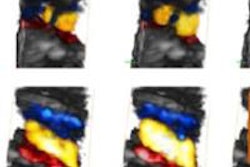A research team from Lund University in Sweden has developed an ultrasound-based method for detecting unstable plaques in the carotid artery, potentially adding a new tool in the fight for earlier detection of cardiovascular diseases such as heart attack and stroke.
The method, which was developed six years ago by Tobias Erlöv when he was a doctoral student in biomedical engineering at the university's Faculty of Engineering, involves a mathematical calculation that can be used to interpret ultrasound signals and determine whether the plaque in the carotid artery is harmful or not, according to the university.
The team believes the method could be useful for identifying patients at risk of developing acute cardiovascular diseases and also for follow-up of patients who have had surgery to remove plaque.
Currently, vascular surgery is only performed if there's excessive blockage due to blood flow from large plaques. However, the stability of plaque can't be determined simply by studying flow rates and plaque sizes; the type of cell is more important, according to the researchers. Harmless plaques consist of connective tissue and smooth muscle cells, while harmful plaques consist of lipids and macrophages and can also involve bleeding.
"We have shown that there is a strong correlation between changes in the center frequency and the size of the reflecting particles," Erlöv said in a statement. "The more harmful substances, the greater the so-called [center] frequency shift."
Thanks to this technique, carotid ultrasound studies in the future may enable surgery to be performed at an earlier stage in some cases and to avoid surgery in others, according to the researchers. The team noted that research studies are currently underway to test the method. For example, the European research collaboration Summit is currently assessing the technique in 1,500 patients, according to the group.



















